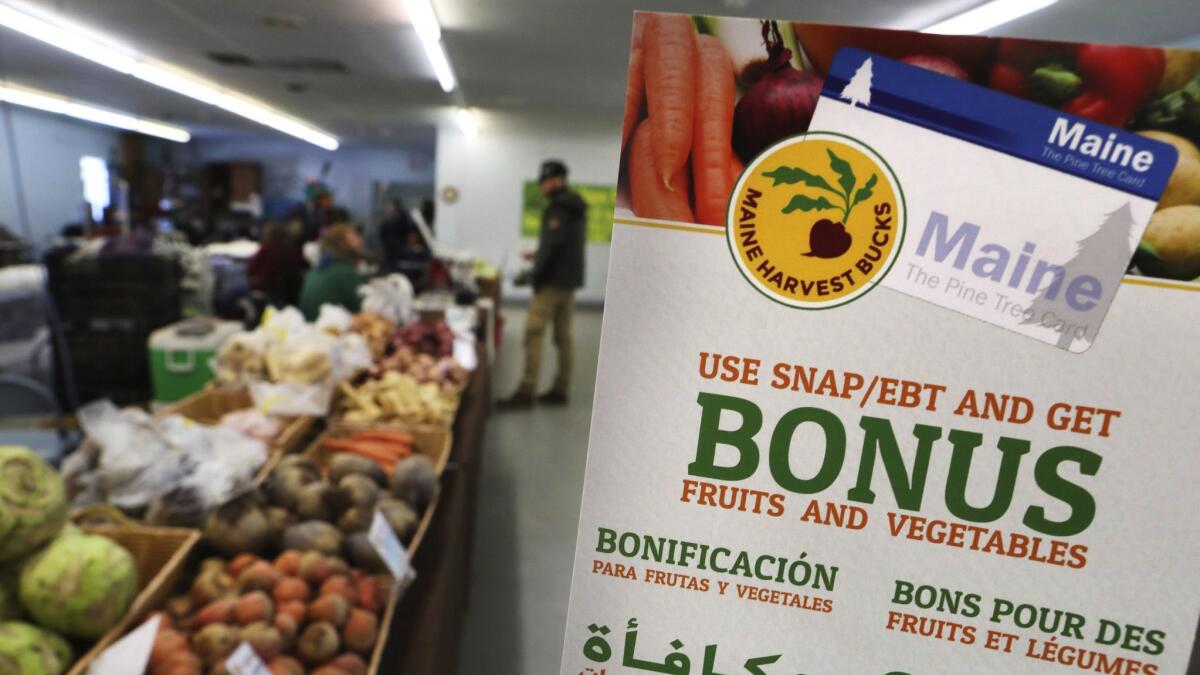Editorial: Making it harder for the poorest Americans to buy food

- Share via
The federal Supplemental Nutrition Assistance Program, better known as food stamps, provides crucial financial aid to nearly 40 million impoverished Americans. The subsidy comes with strings attached, however, including the requirement that able-bodied adults without dependents work or train for employment at least part-time if jobs are reasonably easy to find.
On Thursday the Trump administration proposed to make that work requirement considerably more stringent. If it has its way, it will make life more miserable for some of the poorest Americans, many of whom are working already in low-paying, entry-level jobs.
Why the change? According to the U.S. Department of Agriculture, the goal is to move more able-bodied SNAP recipients to self-sufficiency “through the dignity of work.” It added: “The rule is meant to restore the system to what it was meant to be: assistance through difficult times, not lifelong dependency.”
The overwhelming majority of recipients are not able-bodied, working-age adults; rather, most recipients are children.
The department may claim a noble purpose, but the Grinch-like timing of the announcement less than a week before Christmas and the details of the proposal argue otherwise.
For starters, it’s hard to see what problem the administration is trying to solve, either here or in the similar attacks it’s made on Medicaid and other safety net programs. As of the end of September, 38.6 million Americans were receiving food stamps, costing taxpayers $5.8 billion. That’s significantly fewer than the 43.7 million people who were on food stamps two years ago, and way, way down from the post-recession peak of nearly 48 million in 2013. What’s more, the overwhelming majority of recipients are not able-bodied, working-age adults; rather, most recipients are children.
So the food stamp rolls are shrinking, and most of the benefits by far are going to people who aren’t supposed to be in the workforce. By the USDA’s own admission Thursday, only 6% of the people on food stamps were able-bodied adults between the ages of 18 and 49 who were not working.
And “lifelong dependency” is hyperbole, at least where able-bodied adults are concerned. Citing research by the USDA itself, the Center on Budget and Policy Priorities reported that the people who stay on food stamps the longest “tend to be elderly individuals and people with disabilities.” The center added, “About half of all non-disabled, childless adults who began receiving SNAP left within eight months, on average.”
As we said up front, the program already has work requirements — and unless you meet them, you can’t receive food stamps for more than three months in a three-year period. To meet the existing requirements, recipients must work at least 20 hours a week or take part in an approved job training or workfare program. Under federal law, states are allowed to waive the work requirement if their unemployment rate is at least 10% or if jobs are “insufficient.”
Since 1999, the USDA has used the same definition of “insufficient” jobs as the U.S. Department of Labor: when the unemployment rate has hovered at least 20% over the national average for two years. The new Trump administration proposal, however, would forbid states to waive the work requirement unless their unemployment rate had been at least 20% higher than the national average and at least 7% for the previous two years. If experience is any guide, the change is likely to knock thousands of poor working people off of food stamps simply because they will fail to keep up with the paperwork newly required to maintain eligibility; others will undoubtedly fall off the rolls because they can’t find jobs.
Enter the Fray: First takes on the news of the minute from L.A. Times Opinion »
The USDA argues that the unemployment rate is so low now that states could waive the work requirement even when less than 4.5% of their residents are jobless. But that ignores how difficult it may still be for certain groups within a state — adults without high-school diplomas or newly released inmates, for example — to find work. And the USDA offered no data to show why 7% is a better floor than, say, 5% or 10%.
Worse, simply threatening to cut off food stamps to people who don’t meet the work requirements doesn’t make it any easier for them to overcome the barriers they may face, such as the lack of job training programs in their states or the shortage of child care. Getting people into good jobs is an important part of the battle to reduce poverty, no question. But there’s little connection between the “incentive” the administration wants to offer and the good jobs that can sustain low-income people who often have few skills.
Research shows that most able-bodied adults on the food-stamp rolls held jobs in the year before or after the month they started receiving assistance. In other words, this is a low-income population that slips in and out of work, often because the jobs they can hold come and go. The issue here isn’t a lack of appreciation for the “dignity of work,” it’s a need for better skills and better jobs. The path out of poverty is grueling enough without help to put food on the table.
Follow the Opinion section on Twitter @latimesopinion and Facebook
More to Read
A cure for the common opinion
Get thought-provoking perspectives with our weekly newsletter.
You may occasionally receive promotional content from the Los Angeles Times.









